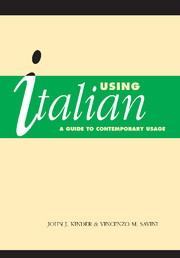Book contents
- Frontmatter
- Contents
- Preface and acknowledgments
- Abbreviations
- 1 Varieties of language
- WORDS AND THEIR MEANINGS
- THE CLAUSE – combining words
- THE SENTENCE – combining clauses
- 25 Italian prepositions
- 26 English prepositions
- 27 Prepositional constructions with verbs and adjectives
- 28 Use of tenses
- 29 Sequence of tenses
- 30 The Subjunctive
- 31 Conditional sentences
- 32 Subordinate clauses
- TEXTS AND THEIR STRUCTURE
- Bibliography
- Italian word index
- Grammar index
32 - Subordinate clauses
Published online by Cambridge University Press: 05 June 2012
- Frontmatter
- Contents
- Preface and acknowledgments
- Abbreviations
- 1 Varieties of language
- WORDS AND THEIR MEANINGS
- THE CLAUSE – combining words
- THE SENTENCE – combining clauses
- 25 Italian prepositions
- 26 English prepositions
- 27 Prepositional constructions with verbs and adjectives
- 28 Use of tenses
- 29 Sequence of tenses
- 30 The Subjunctive
- 31 Conditional sentences
- 32 Subordinate clauses
- TEXTS AND THEIR STRUCTURE
- Bibliography
- Italian word index
- Grammar index
Summary
Subordinate clauses can be thought of in two categories. “Explicit” clauses have the verb in a finite, conjugated form (this is normally what is meant by the term “subordinate clause”). “Implicit” clauses have the verb in a non-finite form: infinitive, gerund, or participle. Compare the following sentences. The first contains an explicit subordinate clause, the second an implicit clause:
Mi sono addormentato mentre guardavo la televisione.
I fell asleep while I was watching television.
Mi sono addormentato guardando la televisione.
I fell asleep watching television.
As these examples show, the same meaning can often be expressed by either an implicit clause or an explicit clause. The difference is usually one of register: implicit clauses are more common in higher registers and particularly in writing.
Explicit subordinate clauses
Explicit subordinate clauses usually come after the main clause, although in most instances the choice is free and a question of style or emphasis. The following types of subordinate clauses tend to come before the main clause:
(i) Temporal clauses
Quando lo vedrò, gli racconterò tutto.
When I see him, I will tell him everything.
(ii) Concessive clauses (expressing “although”: cf. section 30.1.4), e.g.:
Benchè la scadenza sia già passata, accetteremo la Sua domanda.
Although the deadline has already passed, we will accept your application.
(iii) If-clauses (cf. chapter 31), e.g.:
Se ci sei, batti un colpo!
If you're there, knock!
(iv) Limitative clauses, e.g.:
Per quanto ne so, non c'è un numero chiuso in questa Facoltà.
As far as I know, there is no quota in this Faculty.
[…]
Information
- Type
- Chapter
- Information
- Using ItalianA Guide to Contemporary Usage, pp. 421 - 430Publisher: Cambridge University PressPrint publication year: 2004
